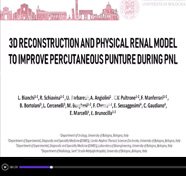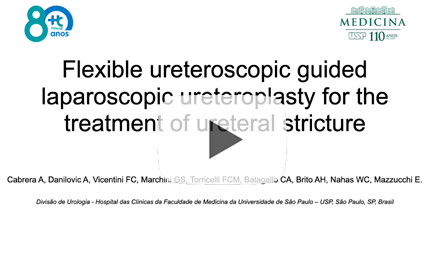Vol. 44 (5): 1046-1046, September – October, 2018
doi: 10.1590/S1677-5538.IBJU.2017.0337
VIDEO SECTION
Fabio Carvalho Vicentini 1, Hugo Daniel Barone dos Santos 1, Carlos Alfredo Batagello 1, Julia Rothe Amundson 2, Evaristo Peixoto Oliveira Neto 1, Giovanni Scala Marchini 1, Miguel Srougi 1, Willian Carlos Nahas 1, Eduardo Mazzucchi 1
1 Divisão de Urologia, Grupo de Endourologia do Hospital das Clínicas, Faculdade de Medicina da Universidade de São Paulo, USP, São Paulo, SP, Brasil; 2 University of Miami, Miller School of Medicine, Miami, EUA
ABSTRACT
Objective: To show a video of a complete supine Percutaneous Nephrolithotomy (csPCNL) performed for the treatment of a staghorn calculus, from the surgeon’s point of view. The procedure was recorded with a GoPro® camera, demonstrating the ten essential steps for a successful procedure.
Materials and methods: The patient was a 38 years-old woman with 2.4cm of left kidney lower pole stone burden who presented with 3 months of lumbar pain and recurrent urinary tract infections. She had a previous diagnosis of polycystic kidney disease and chronic renal failure stage 2. CT scan showed two 1.2cm stones in the lower pole (Guy’s Stone Score 2). She had a previous ipsilateral double J insertion due to an obstructive pyelonephritis. The csPCNL was uneventful with a single access in the lower pole. The surgeon had a Full HD GoPro Hero 4 Session® camera mounted on his head, controlled by the surgical team with a remote control. All of the mains steps were recorded. Informed consent was obtained prior to the procedure.
Results: The surgical time was 90 minutes. Hemoglobin drop was 0.5g/dL. A post-operative CT scan was stone-free. The patient was discharged 36 hours after surgery. The camera worked properly and didn’t cause pain or muscle discomfort to the surgeon. The quality of the recorded movie was excellent.
Conclusion: GoPro® camera proved to be a very interesting tool to document surgeries without interfering with the procedure and with great educational potential. More studies should be conducted to evaluate the role of this equipment.
ARTICLE INFO
Available at: https://intbrazjurol.com.br/video-section/20170337_Vicentini_et_al
Int Braz J Urol. 2018; 44 (Video #13): 1046-1046



